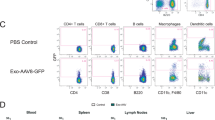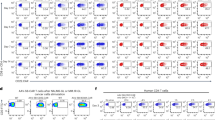Abstract
T-lymphocyte-directed gene therapy has potential as a treatment of subjects with immunological disorders. One current limitation of this therapeutic strategy is low gene transfer efficiency, even when complex procedures are used. We report herein that a recombinant Sendai virus vector (SeV) was able to overcome this issue. Using jellyfish enhanced green fluorescent protein gene (EGFP), we found that SeV was able to transduce and express a foreign gene specifically and efficiently in activated murine and human T cells, but not in naive T cells, without centrifugation or reagents including polybrene and protamine sulfate; the present findings were in clear contrast to those demonstrated with the use of retroviruses. The transduction was selective in antigen-activated T cells, while antigen-irrelevant T cells were not transduced, even under bystander activation from specific T-cell responses by antigens ex vivo. Receptor saturation studies suggested a possible mechanism of activated T-cell-specific gene transfer, ie, SeV might attach to naive T cells but might be unable to enter their cytoplasm. We therefore propose that the SeV vector system may prove to be a potentially important alternative in the area of T-cell-directed gene therapy used in the clinical setting.
This is a preview of subscription content, access via your institution
Access options
Subscribe to this journal
Receive 12 print issues and online access
$259.00 per year
only $21.58 per issue
Buy this article
- Purchase on Springer Link
- Instant access to full article PDF
Prices may be subject to local taxes which are calculated during checkout





Similar content being viewed by others
References
Blaese RM et al. T lymphocyte-directed gene therapy for ADA-SCID: initial trial results after 4 years. Science 1995; 270: 475–480.
Altenschmidt U, Moritz D, Groner B . Specific cytotoxic T lymphocytes in gene therapy. J Mol Med 1997; 75: 259–266.
Misaki Y et al. Gene-transferred oligoclonal T cells predominantly persist in peripheral blood from an adenosine deaminase-deficient patient during gene therapy. Mol Ther 2001; 3: 24–27.
Lam JS et al. Improved gene transfer into human lymphocytes using retroviruses with the gibbon ape leukemia virus envelope. Hum Gene Ther 1996; 7: 1415–1422.
Pollok KE et al. High-efficiency gene transfer into normal and adenosine deaminase-deficient T lymphocytes is mediated by transduction on recombinant fibronectin fragments. J Virol 1998; 72: 4882–4892.
Ayuk F et al. Establishment of an optimised gene transfer protocol for human primary T lymphocytes according to clinical requirements. Gene Therapy 1999; 6: 1788–1792.
Movassagh M et al. Retrovirus-mediated gene transfer into T cells: 95% transduction efficiency without further in vitro selection. Hum Gene Ther 2000; 11: 1189–1200.
Kuhlcke K et al. Highly efficient retroviral gene transfer based on centrifugation-mediated vector preloading of tissue culture vessels. Mol Ther 2002; 5: 473–478.
Hege KM, Roberts MR . T-cell gene therapy. Curr Opin Biotechnol 1996; 7: 629–634.
Tuohy VK, Mathisen PM . T cell design for therapy in autoimmune demyelinating disease. J Neuroimmunol 2000; 107: 226–232.
Rosenberg SA et al. Gene transfer into humans – immunotherapy of patients with advanced melanoma, using tumor-infiltrating lymphocytes modified by retroviral gene transduction. N Engl J Med 1990; 323: 570–578.
Dardalhon V et al. Lentivirus-mediated gene transfer in primary T cells is enhanced by a central DNA flap. Gene Therapy 2001; 8: 190–198.
Buchschacher Jr GL, Wong-Staal F . Development of lentiviral vectors for gene therapy for human diseases. Blood 2000; 95: 2499–2504.
Lamb RA, Kolakofsky D . Paramyxoviridae: the viruses and their replication. In: Fields BN, Howley PM et al (eds). Fields of Virology. Lippincott-Raven Publishers: Philadelphia, 1996, pp 1177–1204.
Collins PL, Chanock RM, Mclntosh K . Parainfluenza viruses. In: Fields BN, Howley PM et al (eds). Fields of Virology. Lippincott-Raven Publisher: Philadelphia, 1996, pp. 1205–1241.
Kumar M, Hassan MQ, Tyagi SK, Sarkar DP . A 45,000-M(r) glycoprotein in the Sendai virus envelope triggers virus-cell fusion. J Virol 1997; 71: 6398–6406.
Eguchi A et al. Identification and characterization of cell lines with a defect in a post-adsorption stage of Sendai virus-mediated membrane fusion. J Biol Chem 2000; 275: 17549–17555.
Glezen WP, Denny FW . Parainfluenza virus. In: Evans AS, Kaslow RA (eds). Viral Infection of Humans. Plenum Medical Book Company: New York, 1997, pp 551–567.
Li HO et al. A cytoplasmic RNA vector derived from nontransmissible Sendai virus with efficient gene transfer and expression. J Virol 2000; 74: 6564–6569.
Yonemitsu Y et al. Efficient gene transfer to airway epithelium using recombinant Sendai virus. Nat Biotechnol 2000; 18: 970–973.
Masaki I et al. Recombinant Sendai virus-mediated gene transfer to vasculature: a new class of efficient gene transfer vector to the vascular system. FASEB J 2001; 15: 1294–1296.
Masaki I et al. Angiogenic gene therapy for experimental critical limb ischemia: acceleration of limb loss by overexpression of vascular endothelial growth factor 165 but not of fibroblast growth factor-2. Circ Res 2002; 90: 966–973.
Yamashita A et al. Fibroblast growth factor-2 determines severity of joint disease in adjuvant-induced arthritis in rats. J Immunol 2002; 168: 450–457.
Ikeda Y et al. Recombinant sendai virus-mediated gene transfer into adult rat retinal tissue: efficient gene transfer by brief exposure. Exp Eye Res 2002; 75: 39–48.
Shiotani A et al. Skeletal muscle regeneration after insulin-like growth factor I gene transfer by recombinant Sendai virus vector. Gene Therapy 2001; 8: 1043–1050.
Moyer SA, Baker SC, Lessard JL . Tubulin: a factor necessary for the synthesis of both Sendai virus and vesicular stomatitis virus RNAs. Proc Natl Acad Sci USA 1986; 83: 5405–5409.
Sha WC et al. Selective expression of an antigen receptor on CD8-bearing T lymphocytes in transgenic mice. Nature 1988; 335: 271–274.
Markwell MA, Paulson JC . Sendai virus utilizes specific sialyloligosaccharides as host cell receptor determinants. Proc Natl Acad Sci USA 1980; 77: 5693–5697.
Okada Y, Tadokoro J . The distribution of cell fusion capacity among several cell strains or cells caused by HVJ. Exp Cell Res 1963; 32: 417–430.
Bunnell BA et al. High-efficiency retroviral-mediated gene transfer into human and nonhuman primate peripheral blood lymphocytes. Proc Natl Acad Sci USA 1995; 92: 7739–7743.
Chuck AS, Palsson BO . Consistent and high rates of gene transfer can be obtained using flow-through transduction over a wide range of retroviral titers. Hum Gene Ther 1996; 7: 743–750.
Chinnasamy D et al. Lentiviral-mediated gene transfer into human lymphocytes: role of HIV-1 accessory proteins. Blood 2000; 96: 1309–1316.
Fehse B et al. Highly-efficient gene transfer with retroviral vectors into human T lymphocytes on fibronectin. Br J Haematol 1998; 102: 566–574.
Watts TH, DeBenedette MA . T cell co-stimulatory molecules other than CD28. Curr Opin Immunol 1999; 11: 286–293.
Kato A et al. Y2, the smallest of the Sendai virus C proteins, is fully capable of both counteracting the antiviral action of interferons and inhibiting viral RNA synthesis. J Virol 2001; 75: 3802–3810.
Biron CA, Sen GC . Interferons and other cytokine. In: Fields BN, Howley PM et al (eds). Fields of Virology. Lippincott-Raven Publishers: Philadelphia, 1996, pp 321–351.
Maus MV et al. Ex vivo expansion of polyclonal and antigen-specific cytotoxic T lymphocytes by artificial APCs expressing ligands for the T-cell receptor, CD28 and 4-1BB. Nat Biotechnol 2002; 20: 143–148.
Kato A et al. Initiation of Sendai virus multiplication from transfected cDNA or RNA with negative or positive sense. Genes Cells 1996; 1: 569–579.
Sakai Y et al. Accommodation of foreign genes into the Sendai virus genome: sizes of inserted genes and viral replication. FEBS Lett 1999; 456: 221–226.
Kolakofsky D et al. Paramyxovirus RNA synthesis and the requirement for hexamer genome length: the rule of six revisited. J Virol 1998; 72: 891–899.
Fuerst TR, Niles EG, Studier FW, Moss B . Eukaryotic transient-expression system based on recombinant vaccinia virus that synthesizes bacteriophage T7 RNA polymerase. Proc Natl Acad Sci USA 1986; 83: 8122–8126.
Yonemitsu Y, Kaneda Y . Hemagglutinating virus of japan liposome-mediated gene delivery to vascular cells. In: Baker AH (ed). Vascular Disease: Molecular Biology and Gene Therapy Protocols. Humana Press: Totowa, NJ, 1999, pp 295–306.
Picker LJ et al. Control of lymphocyte recirculation in man. I. Differential regulation of the peripheral lymph node homing receptor L-selection on T cells during the virgin to memory cell transition. J Immunol 1993; 150: 1105–1121.
Ostrowski MA et al. Both memory and CD45RA+/CD62L+ naive CD4(+) T cells are infected in human immunodeficiency virus type 1-infected individuals. J Virol 1999; 73: 6430–6435.
Jin CH et al. Recombinant Sendai virus provides a highly efficient gene transfer into human cord blood-derived hematopoietic stem cells. Gene Therapy 10: 272–277.
Acknowledgements
We thank Dr Onoe for kindly providing the 2C transgenic mice and M Ohara for providing editorial services.
Author information
Authors and Affiliations
Additional information
This work was supported by a Grant for the Promotion of Basic Scientific Research in the Medical Frontier of The Organization for Pharmaceutical Safety and Research
Rights and permissions
About this article
Cite this article
Okano, S., Yonemitsu, Y., Nagata, S. et al. Recombinant Sendai virus vectors for activated T lymphocytes. Gene Ther 10, 1381–1391 (2003). https://doi.org/10.1038/sj.gt.3301998
Received:
Accepted:
Published:
Issue Date:
DOI: https://doi.org/10.1038/sj.gt.3301998
Keywords
This article is cited by
-
p73 is required for appropriate BMP-induced mesenchymal-to-epithelial transition during somatic cell reprogramming
Cell Death & Disease (2017)
-
Reprogramming human B cells into induced pluripotent stem cells and its enhancement by C/EBPα
Leukemia (2016)
-
Generation of induced pluripotent stem cells from a small amount of human peripheral blood using a combination of activated T cells and Sendai virus
Nature Protocols (2012)
-
Transplantation of sendai viral angiopoietin-1-modified mesenchymal stem cells for ischemic limb disease
Angiogenesis (2010)
-
Sendai viral vector mediated angiopoietin-1 gene transfer for experimental ischemic limb disease
Angiogenesis (2009)



